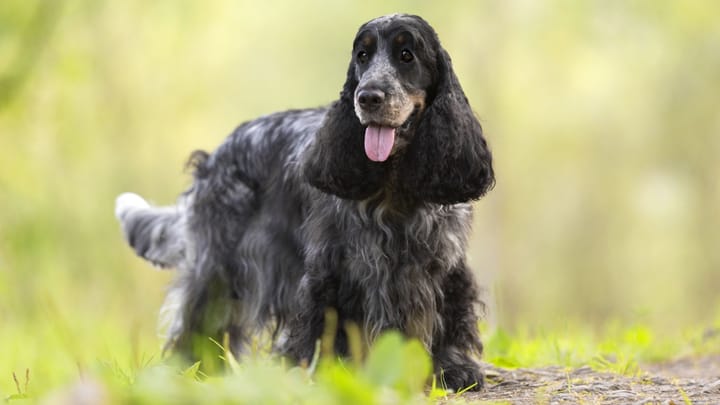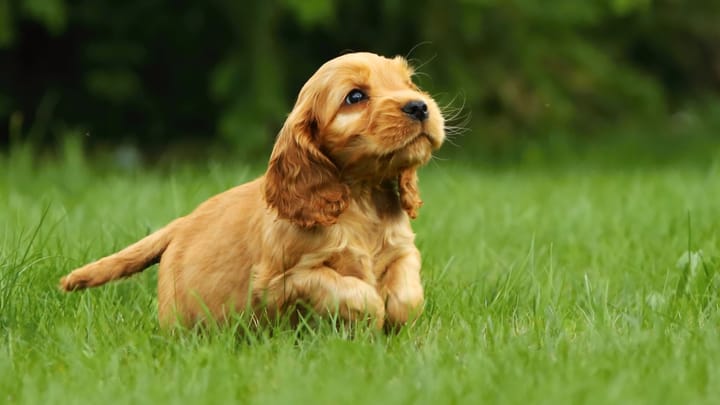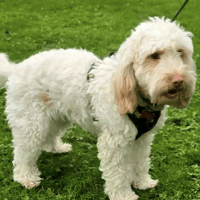Cocker Spaniel
Other names : Cocker, English Cocker Spaniel


The Cocker Spaniel is a charming and affectionate breed known for its boundless energy and gentle nature. Originally bred as a skilled hunting companion, this lively dog has since become a beloved family pet. With expressive eyes, long, silky ears, and a beautifully feathered coat, the Cocker Spaniel is as striking in appearance as it is in personality. Known for their lively and affectionate nature, these dogs can make excellent additions to any family. Their friendly demeanor and playful temperament ensure that there's never a dull moment. Intelligent and eager to please, they respond well to training and thrive in an environment where they receive plenty of attention and exercise. Whether curled up on the sofa or enjoying a brisk walk outdoors, they form strong bonds with their owners. Let's explore what makes the Cocker Spaniel a truly cherished breed.
|
Life expectancy |
The Cocker Spaniel has a life expectancy of between 12 and 14 years |
|
Temperament |
|
|
Size |
Medium
|
|
Adult size |
Female
Between 15 and 15 in
Male
Between 15 and 16 in
|
|
Adult weight |
Female
Between 29 and 31 lb
Male
Between 29 and 31 lb
|
|
Coat colour
The Spaniel can be: a solid colour (black, red, chocolate), barring white, which is not admissible; parti and bi-coloured (black and white, black and tan, brown and tan, orange and white, brown and white, lemon and white) with or without flyspeck; tricoloured (black, white and tan, or brown, white and tan); or roan (either blue, brown, lemon, orange, blue and tan or brown and tan). |
Black Brown Red |
|
Type of coat
The coat is medium-long. The coat lies flat throughout the dog’s body, is of silky texture without ever seeming wirehaired. The hair should not be wavy, curly, nor too abundant. |
Long |
|
Eye colour
The eyes must be brown or dark brown, never light. |
Brown
|
|
Purchase price |
The Cocker Spaniel costs between £500 and £1800 |
While both the English and American Cocker Spaniels share several common traits, such as their wavy coats, affectionate nature, and irresistible charm, there are some notable differences between them.
English Cocker Spaniels are generally slightly larger, with a more athletic build and longer muzzles. Their almond-shaped eyes give them a distinctive, alert expression. In contrast, American Cocker Spaniels are more compact, with rounder heads and a softer, sweeter appearance. They are renowned for their large, expressive eyes that have a heart-melting quality.
Despite their differences in appearance, both breeds share a loving, friendly temperament, making them incredibly popular among dog lovers and ideal companions.
More details about the Cocker Spaniel
Cocker Spaniel: Origins and history
The Cocker Spaniel boasts a rich and intriguing history that traces back centuries. Originating from Spain, these dogs were introduced to England, where they were refined into two distinct breeds: the English Cocker Spaniel and the American Cocker Spaniel.
The term "spaniel" is derived from the Old French "espagnol," meaning "Spanish," highlighting the breed's Iberian roots. Historical records, such as those by Dr. Caius in 1570, mention "spaniels" in Britain. Additionally, works from the late 14th century reference the "English Spaniel," indicating their presence and significance in England for centuries.
In the 19th century, the Cocker Spaniel was primarily used for hunting woodcock, which influenced its name. The breed was divided based on size, with smaller dogs used for hunting smaller birds like quail, leading to the development of the Cocker Spaniel. The Kennel Club in the UK officially recognised the English Cocker Spaniel as a distinct breed in 1892.
While the Cocker Spaniel originated as a hunting dog, today, it is cherished as a family companion. Its affectionate nature, intelligence, and adaptability have made it a beloved choice among dog lovers worldwide.
Physical characteristics of the Cocker Spaniel
The English Cocker Spaniel is a cheerful, robust, athletic and compact dog. The frame’s length is more or less proportionate to the height of the shoulders. The head is chiseled, with a nicely formed skull, a square muzzle and well defined stop. The eyes are large, but not prominent; they give off a smart and gentle expression. The ears are set low, lobe-shaped and pendant: they should be set at the level of the nose, but no lower. The body is strong and compact, the limbs are rather big-boned and upright. The tail is ever so slightly tucked in under the ridge line; it is always in movement (a signature trait of the breed).
FCI classification of the Cocker Spaniel
-
Group 8 - Retrievers - Flushing Dogs - Water Dogs
-
Section 2 : Flushing Dogs
Cocker Spaniel: Characteristics
Cocker Spaniel: Behaviour
Training a Cocker Spaniel
Training a Cocker Spaniel is most effective with positive reinforcement, as they respond well to praise and rewards. Consistency is essential, using the same commands and actions to guide them.
Early socialisation helps them adapt to different environments, sounds, and people, boosting their confidence and preventing antisocial behavior. Establishing a routine creates structure, helping the Cocker Spaniel feel secure and understand what’s expected of them.
Cocker Spaniel: Lifestyle
Breed compatibility Cocker Spaniel
Cocker Spaniel: Purchase price
The price of a Cocker Spaniel puppy typically ranges from £500 to £1,800, depending on lineage and breeder reputation.
In addition to the initial cost, daily expenses include food, which can range from £30 to £50 per month, as well as regular grooming every few months. Veterinary care, vaccinations, and insurance also add to the ongoing costs of ownership.
Cocker Spaniel: Shedding
Average
A Cocker Spaniel sheds moderately throughout the year, with hair loss becoming more noticeable during the moulting seasons of autumn and spring. During these times, daily brushing is necessary to manage the increased shedding and prevent mats from forming. Regular grooming helps keep their coat tidy and reduces the amount of loose fur around the home.
Cocker Spaniel: Grooming
Grooming a Cocker Spaniel can be more demanding for show dogs, in which case a professional groomer may be necessary.
For non-show dogs, a weekly brush is usually sufficient to maintain their coat’s cleanliness and shine. Their floppy ears should be regularly cleaned and monitored as they are prone to ear infections. Regular grooming helps prevent tangles and ensures overall coat health, keeping the dog comfortable and clean.
Cocker Spaniel: Health
Life expectancy is 13 years on average.
The Cocker Spaniel is a robust breed with a long lifespan. To ensure their health, it's important to regularly clean their eyes and, more importantly, check their ears, especially if they live in rural areas. Frequent ear checks help prevent the buildup of dirt or moisture, which can lead to infections or attract harmful pathogens.
Although the Cocker Spaniel is resilient and enthusiastic about working, it’s important not to overexert them during heatwaves. Excessive stimulation in hot weather can lead to discomfort or health issues, so it’s best to provide them with plenty of rest, shade, and hydration during high temperatures.
Despite his robustness, the Cocker Spaniel shouldn't sleep or spend prolonged periods outside during harsh weather conditions, such as cold or rain. They are best kept indoors in such circumstances to ensure their comfort and well-being, as exposure to extreme weather can lead to health issues.
As long as the English Cocker Spaniel receives enough exercise, there’s no reason for them to gain excess weight. However, due to their greedy nature, it's important not to give in to every whim or overindulge them with too many treats. Maintaining a balanced diet and portion control will help keep them healthy and prevent unwanted weight gain.
Cocker Spaniels are prone to several hereditary health issues, including Progressive Retinal Atrophy (PRA), a degenerative eye condition that can lead to blindness. They are also susceptible to Hereditary Nephropathy, a kidney disease that can impact kidney function, and hip dysplasia, a joint condition that affects mobility. Regular veterinary check-ups and a healthy lifestyle can help manage these conditions and maintain overall well-being.











